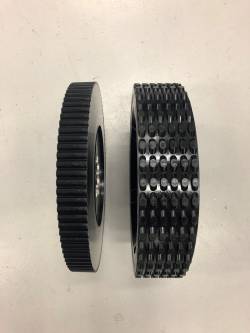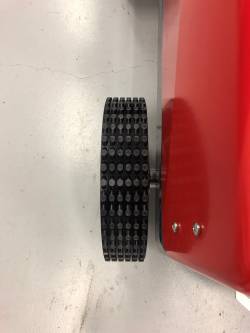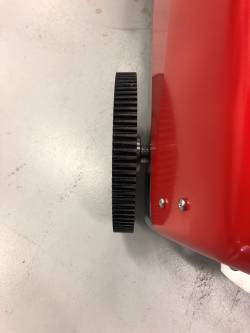Table of Contents
Wheel types
Description
The robot standard wheels are 70 mm wide, made of plastic. There is an option to use narrow wheels if you have narrow aisles in your stables. These narrow wheels are 35 mm wide which means the robot will be 70 mm narrower in total.
If your robot has the 35 mm wheels you should know that it could effect the friction against the floor due to less contact area, specially on very dirty floors (the wheels slipping, leading to incorrect position).
Since the robot gets 70 mm narrower with the 35 mm wheels it could effect the balance of the robot sideways when it washes far out with the telescope combined with uneven/sloping floors.
Robot total width
Flexi-wheel 70 mm = 680 mm wide
Flexi-wheel 35 mm = 610 mm wide
Types
Troubleshooting
The guidance wheels are supposed to be soft so they can swallow obstacles on the wall in the aisle, like doors/gates or similar. Soft wheels will make it easier for the robot to have an even travel along the aisle. However, all stables and aisles don't look the same. If the aisle have doors/gates that sticks out too much, the robot might have a too heavy hit when trying to climb over the obstacle. This could lead to slipping wheels that leads up to incorrect positioning for the EVO Cleaner. It can also lead to "Wheels stuck in forward/backwards direction".
Having problems? Check the following list:
- The guidance wheels are filled with 0.5 bar from the factory. Release some air to make the wheels even softer (if the rim takes the hit from the obstacle, then the wheel is too soft).
- If possible, adjust the angle of the support wheels to a straighter position. Steeper angle pushes harder towards the wall. However, to much change on the angle (compared to the position the robot had when the programs were first made) will change the robot position in the aisle. This can effect the programs.
- If possible, adjust the obstacle on the walls to make the robot run more even.
- Change to bigger wheels. Envirologic offers wheels with 400 mm in diameter instead of the standard 250 mm wheels. There are also higher wheels to use if the interior has horizontal bars. See Different types of guidance wheels above.
There is a lot that comes into play when it comes to guidance wheels and what's possible and what's not.
Things to consider:
- The interior may vary from room to room.
- The angle on the guidance wheels matters. Steeper angle pushes harder on the wall which makes it harder to climb the obstacles.
- Wet floor makes it slippery for the wheels, less traction.
- Wet floor may let the robot push itself sideways easier which may help getting pass the obstacles.
- Dry floors give better traction which may help pushing over obstacles.
- Very dirty floors may cause the wheels to slip.
- High pressurized wheels versus low pressurized wheels.
- If you have narrow driving wheels versus wide driving wheels. Wide driving wheels have better traction (if you have a narrow aisle you might have to use narrow driving wheels).
Choice
For help with the choice of wheels, please see Aisle and robot measurements



